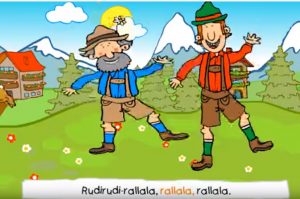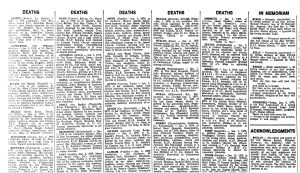
One of my party pieces remains a performance of this, complete with lederhosen-slapping. Please click.
IN the 1980s I lived in northern Italy, up near the border between the provinces of Trentino and Alto Adige, the latter known to most of its German-speaking inhabitants as Sud Tirol. There was a point on the road about 10k from my house north of which gnocchi turned into dumplings, lederhosen hung on the washing lines and speaking Italian in a shop or café would get you no service, just a glare.
I was teaching English in a language school where the majority of other teachers were from the UK and (like many Irish in Europe in those pre-Riverdance days) we Irish regularly had to fend off the irritating presumption than we were British. Gradually, though, we were forced to look at just how much Irish and British culture overlapped:

language, food, sense of humour, currency, television, shops … Compared with the chasm between German and Italian civilizations just 10k north, the Irish and the Brits were practically joined at the hip.
But there was one area that was then and still is utterly distinctive, and that’s the attitude to death and the rituals of death. Very little survives in Ireland of the pagan Celtic culture that created Samhain, the festival of the dead that underlies Halloween – here it’s now an just Anglo-American holiday, mixing cartoon ghouls with Guy Fawkes fireworks. But the dead are still a much more important part of everyday life in Ireland.
First, there is an absolute obligation to be physically present at the moment of death of a family member, almost as if the death has to be caught and preserved. Then, funeral attendance trumps every other social duty, even for remote acquaintances. With funerals held extraordinarily close to death, within three or four days at most, which means dropping everything at very short notice. And a good time tends to be had by all – my uncle Paddy used to prefer funerals to weddings, because you didn’t need an invitation to a funeral.
And then there’s the removal, the lying-in, the wake (now more usual after the funeral), the death notice, the memorial announcements, the mass cards, the month’s mind … While many other Irish customs and traditions have withered, those surrounding death are as tenacious as ever.

Which is good news for those of us who track the Irish dead (aka genealogists). Because getting to funerals is so important, the Irish newspaper death notice is absolutely essential and at its most florid can give a picture of entire extended families and social circles as well as home addresses and burial places. From about 1940, it’s a very rare funeral that didn’t have a death notice, and they’re now all searchable online at the subscription site www.irishnewsarchive.com (25% off with the discount code JGDISC25). They can provide superb evidence of living relatives. And for the past 10 years, www.rip.ie provides a free online version. There is, needless to say, no such thing as www.rip.co.uk or www.rip.com.
One other feature of Irish funeral rituals is that we’re very proud of them. I once boasted about them to an American psychotherapist and genealogist and she responded “Yes, I’ve noticed that the Irish have problems letting go.”
Food for thought. Perhaps eventually ceasing to grieve for the dead is not a betrayal, just an acceptance that they’re gone.
Yet another aspect or Irish family history that I didn’t know. Thanks.
In a world where a funeral via a professional home can cost $15,000 and up here in Michigan and they don’t allow any drinks or food on premises, my family has blended the old Irish traditions with a few newer ones. A long obituary, cremation, a wake at someone’s home or hall with a bar with the dearly departed present, a TV playing of the pictures of their life, and a Mass and luncheon the next day. My family members and parents’ friends stayed for hours at my mother’s wake just as she would have wanted.
My Greatgrandmother from Creeslough, County Donegal set the pattern for funerals in the US in 1945. Hers was so Irish with viewing at home, procession to the Anglican Church(yes some of us are prosestant) burial in the family plot and lots of food, whisky and drink at the wake afterwards. The body was kept company all night. Of course the graves have to be visited and decorated seasonally. The trend continues. Guess I will be next. Hope all enjoy it.
My English-born husband frequently comments that if you see a large crowd outside a church in Ireland, all obviously having a whale of a time, it’s a funeral.
A large crowd outside a church looking stiff and uncomfortable is clearly a wedding.
I learned at 18 about Irish wakes in homes here in the USA. My grandfather died and he was waked at home. I was very sad and of course at 18 one often thinks they know everything. So at 2:00 am as many sat around the kitchen table enjoying themselves, I sat in the living room with my grandfather getting more upset by the minute. Finally I went to the kitchen and told them all that I didn’t think it was right to be so happy when my grandfather was being waked. I had a lot to learn!
Nice to know. I would have to be able to go back to the early 1800’s for my information. Mine came over to America (Baltimore, Maryland, USA) during the famine about 1846. 🙂 I am not sure if anyone stayed, but I do know that at least half the family made it to America. (One household).
As Tip O’Neill ( Irish American politician) once said ” The Irish sure know how to die” I’m very proud that the tradition continues. At an Irish wake last year we were singing happy birthday to one of the mourners, laughing, and drinking heavily. The attendees who were not of Irish heritage thought it was sacrilegious. All us Micks, including the priest, understood it was the right thing to do. Nothing is more fun, and simultaneously sadder, than an Irish funeral.
The funeral is a time to celebrate the life of the deceased, the grieving comes later.
Do you have family from Port Jefferson, New York?
Not to my knowledge.
My Burkes are generally resident around Dublin, my great grandfather having come from North Tipperary about 1860.
Thanks! I will see if I can past my brick wall via death notices. Maybe they brought that custom with them to 19th century Iowa.
Julia you could be related to me! That is if you are descended from Michael Walsh & Mary McGrath & their daughter Margaret
of Mullingar who married a Reilly & settled in Iowa!
Marion
you didn’t mention the ‘afters’. Many dedicated funeral goers have to use great cunning and tact to discover where they are going after (i.e to what Pub or Hostelry where there might be free drink and a feed).
I remember wakes at funeral parlors as a child in Chicago…but certainly EVERY SUNDAY afternoon after mass and lunch, there was a trip to Calvary Cemetary to tend the grave of my Great Grandmother, Mary Finn Whalen Woodman. NOW that tradition led me a few years ago to get the card at the cemetery of the burials. SURPRISE!!!! There were about 10 other relative buried there I had NO idea even existed. Thanks to that I’ve done genealogy and found relatives all over the World from these “silent” ancestors I didn’t even know existed. Just wonderful!
Brilliant as usual, John. 🙂
I can see many parallels between Irish wakes and the way Maori hold a “tangi” for their dead here in New Zealand. The body is brought with much ceremony and tangi (tears) to the marae,-the tribe’s meeting place, where speeches are made, the body is taken inside the wharenui (meeting house) and remains there for about 3 days, with people sleeping there, and parties of visitors coming from all around the country to show their respects. The visitors are all fed, so many hands make light work! Then the people proceed to the urupa (cemetery) for the burial, return to the marae and have a large meal altogether with much singing and community spirit!
This past summer, my favourite uncle died in Toronto, about 500 miles (or about 800 kilometres, I guess) from where I now live. I booked off work, and I hit the road. Didn’t even occur to me that I might attempt to dodge the obligation to be there physically. What an insult to the memory of my uncle that would have been!
My suspicion is that, while many of the old Irish customs died off long ago for Irish emigrant communities (to be more recently replaced by self-conscious Paddy-ism, of course), the Irish funeral culture never did die off, it still dies hard. I can still recall attending funerals as a kid (this in Canada), of old people that I had never even met, because someone had to be there to ‘represent the family’ and to pay our respects, it was a question of decency. And also, my parents didn’t think it was weird to bring a child to a funeral (also Old World, and totally out of step with the best advice offered by the best experts, of course).
Great stories thank you. Kay Johnson. Australia.
Irish funerals have always seemed to be celebrations of life, even if the life being celebrated was not a particularly good one.
From a genealogist’s standpoint, the obituaries can be very helpful if they happen to list the attendees that include family members.
Thank you!